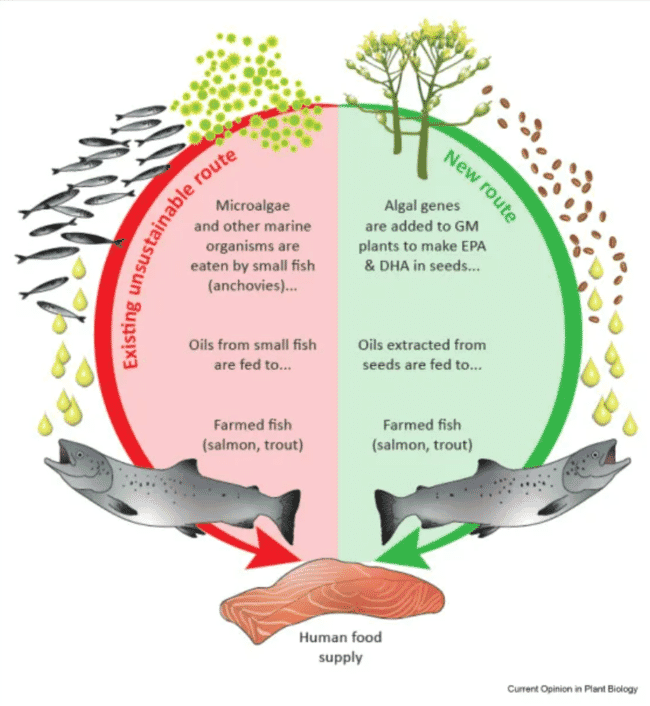
Aquaculture researchers have been exploring ways to reduce the sector's dependence on marine ingredients for aquafeed
In the study the researchers describe the “validation” phase in which oils from genetically modified plants are used as substitutes for fish oils in aquaculture diets and report field tests.
Vegetable biotechnology
Plant biotechnology can be divided into two waves of innovation, the first was made up of transgenic plants that are tolerant to herbicides; while the second wave is characterised by the improvement in nutrient content.
At the forefront of the second wave of GM plant innovation are vegetables that have been engineered to accumulate omega-3 polyunsaturated fatty acids in their oilseeds, providing a new source of fatty acids.
Transgenic plants to synthesise EPA + DHA
The omega-3s eicosapentaenoic acid (EPA) and docosahexaenoic acid (DHA) are found in fish oils and are almost exclusively restricted to aquatic food webs.

Schematic representation of the requirement for omega-3 acids in marine aquaculture and how fatty acids derived from genetically modified plants can be used as substitutes. © Napier and Betancor (2023)
According to the researchers, significant progress has been made in two host plant species: camelina and canola, despite the fact that there are significant differences in terms of the set of genes and regulatory elements that were used for the synthesis of EPA + DHA.
Validation in fish feeding trials
“To date, most research on fish using GM-derived oils rich in n-3 LC-PUFA has focused on Atlantic salmon (Salmo salar),” the study authors report.
“This is largely due to the fact that salmonids are the main consumer of fish oils due to the need for energy-dense feed for farming, in addition to its high final value,” they cite.
The study highlights that oils derived from omega-3-rich camelina and canola have been successfully tested in various life stages of fish:
- Freshwater fingerlings fed 4 percent or 8 percent inclusion rates n-3 transgenic canola oil exhibited similar growth and survival to those fed a diet containing fish oil as the main lipid source.
- In seawater, no differences were found in the growth of smolts fed with camelina oil rich in EPA or EPA+DHA compared to fish fed with a diet rich in fish oil.
Likewise, the researchers cite that all the trials reported that fish fed with oils derived from genetically modified plants had better levels of n-3 LC-PUFA in their meat, compared to a control commercial diet.
“Enhanced EPA + DHA levels in meat have been a common finding in other studies where teleost fish were fed LC-PUFA omega-3 vegetable oils, like other fatty species, including rainbow trout (Oncorhynchus mykiss), but also sea bream (Sparus aurata) and sea bass (Dicentrarchus labrax),” they describe.
Based on the study results, perhaps the most important thing to note is that none of the trials conducted to date have reported any adverse effects in fish fed these new oils, demonstrating the potential for fatty acids to be exploited.
New steps and new approaches
“Validation of these new oils as safe and effective substitutes for ocean-sourced fish oils was a key step in reducing the risk of this technology and helping it advance to market,” the researchers note.

Plant biotechnology can help us use more sustainable plant-derived feed and food products © Loch Duart
They also highlight that a greater awareness of the problems associated with sustainability and the environmental footprint have given additional impetus to commercialisation.
“A recent analysis confirms the significant variation between the demand for long-chain omega-3 polyunsaturated fatty acids and the available supplies from our oceans, which is currently estimated to provide only ~30 percent of the recommended levels of EPA and DHA for the population worldwide,” they said in a press release.
According to the study authors, this highlights the pressing need for alternative supplies of these important fatty acids, especially given their protective health role against cardiovascular disease and other metabolic pathologies that now blight the lives of many millions of people. In addition to the sustainable synthesis of EPA and DHA via transgenic plants, a number of microbial systems (predominantly algae) are being established.
“Although the novel plant platforms described above are GM with associated regulatory burdens, they have the advantage of using pre-existing infrastructure and knowledge that underpin modern agriculture, allowing for rapid scaling up and incorporation into production cycles,” they conclude.
“Expanding our use of plant-derived feed and food products will be essential to operating within planetary limits and collectively we need to take a different approach to ensure optimal nutrition for all – plant biotechnology can play a key role in enabling this.”
The study was financially supported by the BBSRC (UKRI).




